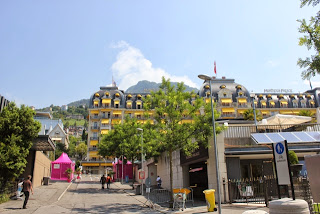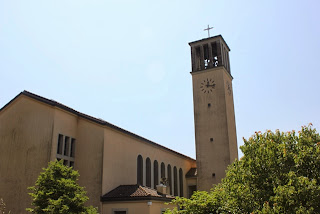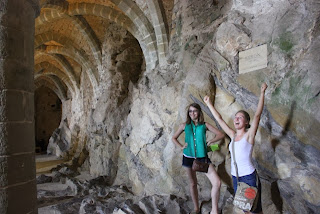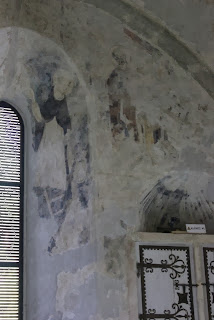Allison knew about the city, because it was the last home of Vladimir Nabokov, the Russian writer, and he is buried there. I wanted to see more of Switzerland, so we all agreed to trek on over to Montreux!
 We arrived in the train station, but discovered that you can't buy tickets from a person, only from a machine. My card wouldn't work in the machine, so we had to run to the bank and then go back to the machine.
We arrived in the train station, but discovered that you can't buy tickets from a person, only from a machine. My card wouldn't work in the machine, so we had to run to the bank and then go back to the machine.As usual, we left later than we intended.
The train ride was beautiful.
 Montreux is also beautiful. It's directly on the lake. It's a pretty small town built into a relatively small mountain. Only about 25,000 people live there. Almost half of the population are foreigners.
Montreux is also beautiful. It's directly on the lake. It's a pretty small town built into a relatively small mountain. Only about 25,000 people live there. Almost half of the population are foreigners.Here's little background history of the town. It connected two major Roman cities, so it was an important settlement.
The Princes of Savoy were in charge of the town for a while, along with the Lords of Oron, depending on the time.
 After the Burgundian War, the Swiss in Bern occupied the city, until Napoleon liberated them in 1798.
After the Burgundian War, the Swiss in Bern occupied the city, until Napoleon liberated them in 1798.
During the Reformation, Huguenots from Italy used Montreux as a refuge.
The lake is just beautiful! I loved all the flowers along the water.
We arrived in town and got breakfast (Nutella crepes, what a surprise!) then headed into town.
The main character's in "A Farewell to Arms" stayed in Montreux. Unfortunately, I did not really enjoy "A Farewell to Arms" when I read it, so I did not remember this detail.
Deep Purple's album "Machine Head" was recorded in Montreux. The song, "Smoke on the Water" is about the time a Frank Zappa fan set the Montreux Casino on fire with a flare gun.
 Apparently, Zelda Fitzgerald, wife of F. Scott Fitzgerald once lived in Montreux, but I think she may have been in a mental institution, so she wasn't living there for fun. That, or she was just in the hospital. I could be spreading untrue rumors.
Apparently, Zelda Fitzgerald, wife of F. Scott Fitzgerald once lived in Montreux, but I think she may have been in a mental institution, so she wasn't living there for fun. That, or she was just in the hospital. I could be spreading untrue rumors.At other times, Freddie Mercury (Queen), Tony Lewis, Rousseau, Igor Stravinsky, and others lived there. Others include Shania Twain, but she doesn't seem quite as important.
While walking along the water, we noticed a lot of tents and stalls, which I thought was weird for such a small town.
Here's the hotel from another angle.
A view of the town from our walk to the cemetery.
We walked in circles for a while around the cemetery, before finally climbing the mountain to go inside the cemetery.
We walked through a couple random streets that did not seem correct. It's really amazing that we survived this trip without accidentally wandering into something dangerous while following maps that were completely wrong.
At least it was beautiful!
This is the neighborhood around the cemetery.
A view of the alps.
This is the church where the cemetery is located.
The view from the cemetery towards the lake.
The view from the cemetery towards a villa up on a hill.
Side note: Every time I type "cemetery" I spell it wrong.
The view in another direction.
Some of the surrounding graves.
There's Adrienne.
And there's Nabokov.
We looked around the cemetery a bit more, then headed back into town.
The Swiss really dress up their graves. They were so fancy!
 We took our time heading back into town. It was a couple weeks into our trip at this point and our feet were reaching breaking point.
We took our time heading back into town. It was a couple weeks into our trip at this point and our feet were reaching breaking point.No, they were not literally broken. But, they were definitely doing that thing where you go to sleep and they hurt and you wake up and they hurt.
We sat in a playground.
 Then we sat along the water. Then, we sat on some rocks with our feet in the water.
Then we sat along the water. Then, we sat on some rocks with our feet in the water.When we finally made it into town, we discovered that we'd accidentally gone to Montreux during the Montreux Jazz Festival. Apparently, it's a huge deal but I'd never heard of it.
 Past performers include Alanis Morrisette, Annie Lennox, B.B. King, Billy Idol, Alice Cooper, the Black Eyed Peas, Bob Dylan, Santana, Chicago, Deep Purple, Ella Fitzgerald, Eric Clapton, Etta James, Jethro Tull, Johnny Cash, Led Zeppelin, Mavin Gaye, Miles Davis, Muse, Nina Simone, Pink Floyd, Radiohead, Ray Charles, Stevie Ray Vaughn, the Corrs, the Moody Blues and the Strokes.
Past performers include Alanis Morrisette, Annie Lennox, B.B. King, Billy Idol, Alice Cooper, the Black Eyed Peas, Bob Dylan, Santana, Chicago, Deep Purple, Ella Fitzgerald, Eric Clapton, Etta James, Jethro Tull, Johnny Cash, Led Zeppelin, Mavin Gaye, Miles Davis, Muse, Nina Simone, Pink Floyd, Radiohead, Ray Charles, Stevie Ray Vaughn, the Corrs, the Moody Blues and the Strokes.It's quite the diverse group when Alanis Morrisette and Ella Fitzgerald are on the same list.
Apparently this year, Deep Purple performed this year, but not on the day that we attended the festival.
We bought some ice cream, sat on a hill and listened to some jazz for a while.
We wanted to see one of the castles in Montreux, so we made our way over to the castle.
We didn't know how to get there, but finally figured it out when we asked for directions. We had to take a bus and arrived without trouble.
It's called the Château de Chillon, or Chillon Castle. It's built into a rock, which you can see very clearly in the dungeons, where the rock is part of the floor. Apparently the dungeon was very scary for prisoners, because they could clearly hear the lake, but didn't know if they were underwater or not.
Walking over to the castle.
There it is!
The girls in front of the castle.
Adrienne, Anna and I in front of the castle.
The top of the castle.
 The lake surrounds the rock that the castle sits upon.
The lake surrounds the rock that the castle sits upon.The view of the lake and the highway going through the mountains. That highway looks a bit terrifying.
There's a flower on the wall.
The castle is 100 separate buildings that were eventually connected together. The site of the castle has been occupied in some way since the Bronze Age. They don't know how old the oldest parts of the castle are, but the oldest written record is from around 1150. The document talks about the Counts of Savoy controlling the castle and the routes along Lake Geneva.
If you want to read a more thorough history of the castle, you can visit the castle's website here.
 Lord Byron visited it and, naturally, marked it with his name like everywhere he's been. Well, maybe not everywhere but I swear he's mark a lot of the places I've visited, Cape Sounion in Greece coming to mind.
Lord Byron visited it and, naturally, marked it with his name like everywhere he's been. Well, maybe not everywhere but I swear he's mark a lot of the places I've visited, Cape Sounion in Greece coming to mind.He wrote a poem about a monk/politician imprisoned in the castle in the 1500's, called "The Prisoner of Chillon"

This is the castle crypt.
You can clearly see here that the castle is built into the rock.
 A view of the lake from the dungeons.
A view of the lake from the dungeons.The walls.
 Some stairs leading to a miniature door.
Some stairs leading to a miniature door.Adrienne and Anna weeping because they've been imprisoned.
And they've been rescued!
Yay! Above their heads is the Lord Byron sign.

Here I am. I am only able to get normal pictures when nobody else is in them.
Lord Byron!
Allison and Lord Byron's sign.
I've now been imprisoned.
Byron.
That little square is where Byron carved his name into the pillar.

 This was pitch black. I decided to take a picture of it to see what it was.
This was pitch black. I decided to take a picture of it to see what it was.Bad idea. It's terrifying.
And we're away from the terrifying hole of terro.

The walkway of the castle is up there. Well, one of the walkways.
 This band was playing. It was quite entertaining.
This band was playing. It was quite entertaining.People were laying on pillows while watching the band.
 The highway above the castle walls.
The highway above the castle walls.
Old paintings on the walls.
An old furnace.

I believe these are old family crests.
This spiral staircase was built in 1336. It was the Count or Duke's private staircase leading to a personal chapel.
A well used fireplace.

This was weird.
These are the latrines. For some reason, the museum felt the need for extensive signs about the history of the toilets.
I learned that the latrines were primarily used for the disposal of wastes (duh). There were 2 types of latrines: internal and external. The internal latrines would collect inside the castle. The external latrines were at the windows over the lake.

In case of attack, the bay window latrines could be used as a firing position, but were a weak point of the castle because they provide a foothold for people to climb into the castle.
The internal latrines were much better concealed, but could also be used to infiltrate the castle, which a sign said "albeit unpleasant and evil smelling."
But, I guess the latrines in Chillon did not have these weaknesses, because they emptied into the lake. So that sign seems unnecessary.
There were also two quotes among the information.
The first one: "What is the most joyful thing in all the world? 'Tis a fart! For it sings from its birth until it fades away."

The second quote: What is the most noble and upright plant of the forest? 'Tis the holly, for no one uses it to wipe his behind."
The quotes are of unknown origin, at least unknown to me.

 This is the personal chapel at the bottom of the staircase.
This is the personal chapel at the bottom of the staircase.This is the Grand Hall of the Count.
This is the Torture chamber.
The ceiling, which is very interesting.
Another furnace. This one is more beautiful than the other one.
Very intricate with so much detail in the painting.


The castle and walkway.
Another flower on a wall.

We were able to climb to the top of these terrifying staircases to get the view lake from the top of the castle.
It's very beautiful!
After we finished at the castle, we headed back into town, got some lunch quickly at the same restaurant we got breakfast at, then headed back into Geneva.
We had to wake up at 4:30 to catch our plane to Hungary, so we went to bed early.

Well, Allison and Anna tried. They had some difficult when the fire alarm went off at 2AM for a very long time. Then, their hostel made them pay 10 dollars more than the reservation said it would.
We missed the first train to the airport, or it didn't exist that day. That caused a lot of stress for me. We arrived at the airport and the line for Easyjet was ENORMOUS. Apparently, ALL of their flights were scheduled between the hour of 6:30 and 7:30. Our flight was at 7:20. Geneva is a main hub of Easyjet so a ton of flights were leaving and all the people in line were rushed for time.
And apparently a ton of people thought it was a good idea to arrive 10 minutes before their flights left. They'd call people forward for a Barcelona flight and a bunch of people would go running. That happened repeatedly, so the line took forever.
 By the time we finally made it through the line, we had 45 minutes until our flight took off. Security took forever. Somehow, Allison and Anna, even though we were standing in the same spot, got placed into the speedy line and Adrienne and I were cut off from it.
By the time we finally made it through the line, we had 45 minutes until our flight took off. Security took forever. Somehow, Allison and Anna, even though we were standing in the same spot, got placed into the speedy line and Adrienne and I were cut off from it.Then, by the time we got through security, we had about 5 seconds to get to our gate. We were at D gate and the sign just past security said that D Gate was 15 minutes away. We sprinted through the airport and arrived at the gate just as people were getting in line to board. Somehow. It is a miracle that we were able to get on that plane. And we had enough time to buy some Swiss chocolate, which was wonderful. I ate it at separate times over several months. So delicious.
I swear, I spend half my time sprinting through airports, even when I'm completely on time. It's so annoying. No wonder I'm a worrier.
We had an uneventful flight where I slept and read my book. We arrived in Budapest at about 9AM, once again not receiving a stamp, which is so irritating and Nora was waiting for us! But, that will be the next blog!






























































































Some thoughts from this post: First of all, I got a quick run-through of the Montreaux pictures when you got back, and somehow thought your impression was that it wasn't as interesting as other cities. That is completely false! The castle is fascinating, the town is gorgeous, there's history, history, history. The most important historical fact: The burning of the Montreaux Casino and the creation of "Smoke on the Water" - but that's just me. Other thoughts: (1) That castle is amazing, and so are the pictures to go with (2) I agree about sprinting through airports. I can't remember an airport I didn't sprint through, and can only think of Dublin where we were trapped and sleeping (3) Regarding the "fart" and "holly" poems in the castle - I'm thinking the origin for both is Lord Byron himself, who probably carved it into a wall. And finally (4) Latrines: Who knew?
ReplyDelete